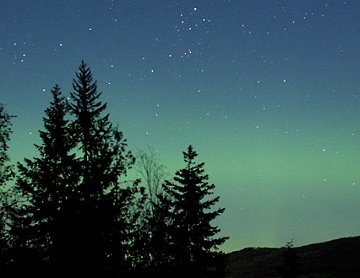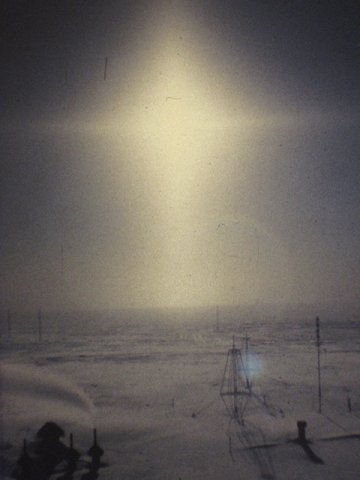| FATHER'S DAY: Skip the tie. This year, give Dad the stars -- a gift subscription to Space Weather PHONE. | | | NLC ALERT: Noctilucent cloud season is underway. In the past week, sky watchers have spotted glow-in-the-dark electric blue tendrils over England, Canada, Ireland, Northern Ireland and the Netherlands. Check the photo gallery for observing tips and be alert for NLCs! NORTHERN LIGHTS: A solar wind stream hit Earth last night, sparking a storm of magnitude 5 on the 0 to 9 Kp scale of geomagnetic storms. In Lumby, British Columbia, amateur astronomer Yuichi Takasaka looked up from a new telescope mount he was testing and noticed that the skies had turned green: 
"It was nice to see auroras in June," he says. (Note: Auroras tend to avoid solstices and prefer equinoxes, so June auroras are rare.) Sky watchers at high latitudes should remain alert for auroras tonight. The solar wind continues to blow and more geomagnetic storms are in the offing. EDITOR'S NOTE: Normally, Spaceweather.com features sky scenes no older than a few days. "Now" is paramount. But occasionally a 46-year-old photo from the ends of the Earth calls for attention. Hence the following: HALO CROSS: "Back in 1962," recalls John Turtle, "I was at Byrd Station (80ºS, 120ºW) as part of the United States Antarctic Research Program. The station was housed in large tunnels under the snow's surface. One day in June, I emerged from a tunnel hatch and witnessed a breathtaking phenomenon. Hanging in the sky, there was a great white luminous cross with the Moon in the middle. I wasn't sure if I should drop to my knees or run for my camera." (He ran for the camera.) "This picture was taken with a Nikon Reflex camera on slide film we processed in the station's photolab." 
"Do you have an expert who can explain this?" asks Turtle. Yes. "This is a halo cross," says atmospheric optics expert Les Cowley. "It is rare and only occurs when the air is very cold because diamond dust ice crystals are required to make it. The crystals are plate-shaped. Reflections from their vertical faces make the horizontal arms of the cross. Reflections from the big top and bottom faces of the crystals make two vertical pillars." "The halo cross is beloved by artists and illustrators," says Cowley. Antarctic explorers like it, too.
May 2008 Aurora Gallery
[Aurora Alerts] [Night-sky Cameras] | 
